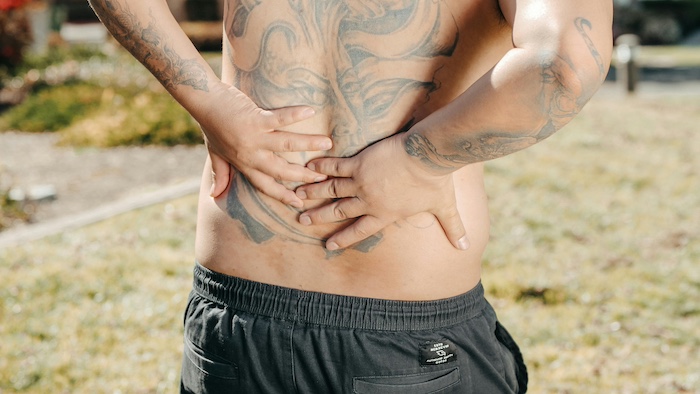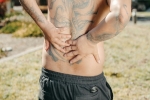
Many treatment options for low back pain can be tailored to an individual patient’s needs. Treatments include care administered at home, medicinal remedies, alternative care, or even surgery.
Depending on the patient's diagnosis, some treatments may be more effective than others. Many people find that a combination of treatments is best.
Self-Care for Low Back Pain
Basic remedies applied at home can be effective for treating mild or acute pain from muscle strain, as well as reducing the effects of chronic, severe pain. Self-care is administered by the individual and can easily be adjusted. These methods include:
Short rest period
Many episodes of lower back pain can be improved by briefly avoiding strenuous activity. It is not advised to rest for more than a few days, as too much inactivity can make healing more difficult.
Activity modification
One variant of resting is to stay active but avoid activities and positions that aggravate the pain. For example, if long periods of sitting in a car or at a desk make the pain worse, then set a timer to get up every 20 minutes and walk around or gently stretch. If standing makes the pain worse, avoid chores that require standing such as washing dishes at the sink. Avoiding, or minimizing, activities and positions that worsen the pain will help prevent or reduce painful back spasms and allow for a better healing environment.
Heat/ice therapy
Heat from a warm bath, hot water bottle, electric heating pad, or chemical or adhesive heat wraps can relax tense muscles and improve blood flow. Increased blood flow brings nutrients and oxygen that muscles need to heal and stay healthy. If the lower back is painful due to inflammation, ice or cold packs can be used to reduce swelling. It’s important to protect the skin while applying heat or ice to prevent tissue damage.
Alternating heat and ice can be especially helpful when returning to activity: applying heat before activities helps relax muscles, allowing for better flexibility and mobility; applying ice after activity reduces the chances of an area becoming irritated and swollen from exercise.
Over-the-counter pain medications
The most common over-the-counter (OTC) medications are aspirin (e.g., Bayer), ibuprofen (e.g., Advil), naproxen (e.g., Aleve), and acetaminophen (e.g., Tylenol). Aspirin, ibuprofen, and naproxen are anti-inflammatory medicines, which alleviate low back pain caused by swollen nerves or muscles. Acetaminophen works by interfering with pain signals sent to the brain.
Self-care treatments generally do not need guidance from a doctor but should be used carefully and attentively. Any type of medication carries possible risks and side effects. If a patient is unsure which kinds of self-care would work best, talking to a doctor is advised.
Exercises for Low Back Pain
Physical therapy is usually part of a low back pain management regimen. Types of exercises used to rehabilitate the spine include:
Stretching
Almost everyone can benefit from stretching muscles in the lower back, buttocks, hips, and legs (especially the hamstring muscles). These muscles support the weight of the upper body. The more mobile these muscles are the more the back can move without injury. It is typically advised to start a small stretch for 20 to 30 seconds and stop a stretch if it causes pain.
Strengthening exercises
Strengthening the abdominal, hip, and gluteus muscles that support the spine, also called the core muscles, can help relieve low back pain. Two common programs are the McKenzie method and Dynamic Lumbar Stabilization.
- The McKenzie method extends the spine by building core muscle strength, reducing pain caused by compressed spinal structures such as a herniated disc caused by a compressed disc space.
- Dynamic Lumbar Stabilization strengthens back muscles to maintain a patient’s “neutral spine,” or the posture that feels most comfortable.
Low-impact aerobics
Low-impact aerobic exercise increases the flow of blood and supports healing from an injury without jarring the spine. Low-impact aerobics can include using stationary bikes, elliptical or step machines, walking, and water therapy. People with low back pain who regularly do aerobic exercise report fewer recurring pain episodes and are more likely to stay active and functional when pain flares.
Any exercise that elevates the heart rate for a sustained period benefits the body. Regular physical activity is important for maintaining the range of motion and flexibility of a healthy spine. When spinal structures go unused for too long, stiffness and discomfort can worsen.
Precision Pain Care and Rehabilitation has two convenient locations in Richmond Hill – Queens, and New Hyde Park – Long Island. Call the Queens office at (718) 215-1888 or (516) 419-4480 for the Long Island office to arrange an appointment with our Interventional Pain Management Specialists, Dr. Jeffrey Chacko or Dr. Sonny Ahluwalia.













